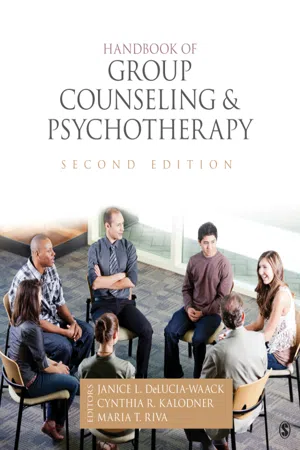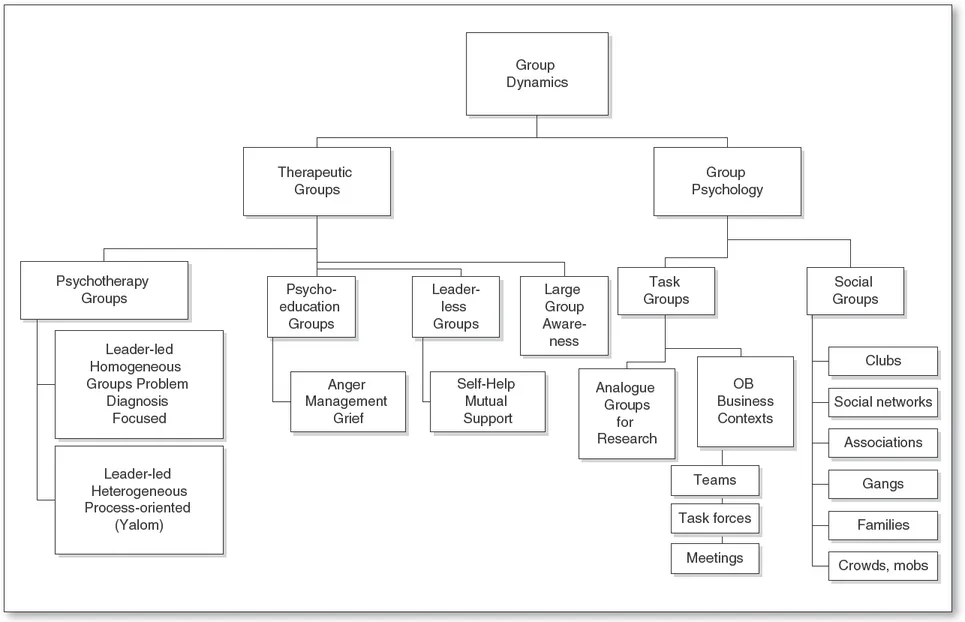
Handbook of Group Counseling and Psychotherapy
Janice L. DeLucia-Waack, Cynthia R. Kalodner, Maria T. Riva
- 656 pages
- English
- ePUB (mobile friendly)
- Available on iOS & Android
Handbook of Group Counseling and Psychotherapy
Janice L. DeLucia-Waack, Cynthia R. Kalodner, Maria T. Riva
About This Book
This book is designed to serve as a core text for advanced and graduate students and researchers alike. Each chapter reviews the literature and current research related to its topic and provides suggestions for practice for psychoeducational, counselling and therapy groups based on the review. Major topics in the field of groups are included: history; best practices; settings; groups across the lifespan; special topics; multicultural groups; as well as critical issues and emerging themes in group counselling and psychotherapy.
Key features include:
-integration of current research and practice
-includes psychoeducational, counseling, and therapy groups for all topics
New to this edition:
-additional chapters on cutting edge themes
-thoroughly updated research
-more pedagogical elements (discussion questions, activities, resources, case examples and key terms, etc.)
-test bank and powerpoints.
Frequently asked questions
Information
Part I Current and Historical Perspectives on the Field of Group Counseling and Psychotherapy
Introduction
Chapter 1 The History of Group Counseling and Psychotherapy

Note: Thank you to Donelson Forsyth for his help on this flow chart.
Source: © By permission of Oxford University Press, USA.
A Historical Review
Table of contents
- Cover
- Half Title
- Acknowledgements
- Title Page
- Copyright Page
- Contents
- About the Editors
- Contributing Authors
- Acknowledgements
- Introduction to the Second Edition of the Handbook of Group Counseling and Psychotherapy
- Part I Current and Historical Perspectives on the Field of Group Counseling and Psychotherapy
- Chapter 1 The History of Group Counseling and Psychotherapy
- Chapter 2 A Unifying Theory for Group Counseling and Psychotherapy
- Chapter 3 Group Dynamics and Development
- Chapter 4 Therapeutic Factors: Current Theory and Research
- Chapter 5 Process and Outcome in Group Counseling and Psychotherapy: A Perspective
- Part II Best Practices of Group Counseling and Group Psychotherapy
- Chapter 6 Guidelines for Ethical and Legal Practice in Counseling and Psychotherapy Groups
- Chapter 7 Effective Processing in Groups
- Chapter 8 Selecting and Using Activities in Groups
- Chapter 9 Effective Group Leader Skills
- Chapter 10 Unleashing the Healing Power of the Group: The Mutual Aid Process
- Chapter 11 An Overview of Current Research and Best Practices for Training Beginning Group Leaders
- Chapter 12 Supervision of Group Leaders
- Chapter 13 Measures of Group Process, Dynamics, Climate, Behavior, and Outcome: A Review
- Chapter 14 Best Practices in Group Counseling and Psychotherapy Research
- Part III Introduction to Multicultural and Diverse Counseling and Psychotherapy Groups
- Chapter 15 Understanding Racial/Cultural Identity Development Theories to Promote Effective Multicultural Group Counseling
- Chapter 16 Group Therapy with Native People
- Chapter 17 Group Counseling for African Americans: Research and Practice Considerations
- Chapter 18 Group Counseling with Asians
- Chapter 19 Psychoeducational and Counseling Groups with Latinos/as
- Chapter 20 Group Work with Gay, Lesbian, Bisexual, Transgender, Queer, and Questioning Clients
- Chapter 21 Group Counseling Services for Persons with Disabilities
- Chapter 22 Group Work with Those in Later Life
- Chapter 23 Using Groups to Facilitate Social Justice Change: Addressing Issues of Privilege and Oppression
- Part IV Introduction to Counseling and Psychotherapy Groups in Special Settings
- Chapter 24 Advancing Evidence-Based Group Work in Community Mental Health Settings: Methods, Challenges, and Opportunities
- Chapter 25 Group Work in Schools
- Chapter 26 Group Work in Colleges and University Counseling Centers
- Chapter 27 Groups in Behavioral Health Settings
- Chapter 28 Group Treatments within the Department of Veterans Affairs
- Part V Introduction to Special Topics
- Chapter 29 Groups for Depression
- Chapter 30 Groups for Anxiety Disorders
- Chapter 31 Group Psychotherapies for Complicated Grief
- Chapter 32 Group Approaches for Addictive Behaviors
- Chapter 33 Group Work with Individuals who have Committed Interpersonal Violence
- Chapter 34 Group Work with Offenders and Mandated Clients
- Chapter 35 Group Psychotherapy and Insecure Adult Attachment
- Chapter 36 Groups for Survivors of Childhood Sexual Abuse
- Chapter 37 Mindfulness and Group: Mindfulness-Based Stress Reduction and Dialectical Behavior Therapy
- Chapter 38 Psychoeducational and Counseling Groups to Prevent and Treat Eating Disorders and Disturbances
- Chapter 39 Psychoeducational and Counseling Groups for Bullying
- Chapter 40 Women's Groups: Research and Practice Trends
- Chapter 41 Gender-Sensitive Group Counseling and Psychotherapy with Men
- Chapter 42 Prevention Groups
- Chapter 43 Career and Transition Counseling in Groups
- Chapter 44 Adventure Therapy with Groups
- Chapter 45 Post-Disaster Group Counseling: A Multicultural Perspective
- Chapter 46 Counseling and Therapy Groups with Children and Adolescents
- Reflections and Final Comments
- Index